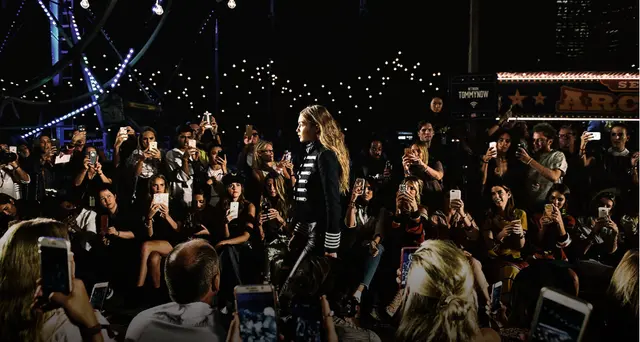Following months of industry speculation on the subject, on February 5th 2016, Burberry became the first major fashion house to announce a realignment of its show calendar by combining men’s and women’s collections into twice-annual seasonless shows. That very same day,Tom Fordannounced a plan to postpone his fashion show for six months to show in September and make the collection immediately available to consumers.
Within a week, they were joined byTommy Hilfiger,Paul Smithand a number of smaller designer brands — all publicly announcing a shift to some form of fashion immediacy strategy, seeking to better rationalise the fashion show calendar for consumers and capitalise on immediate demand for runway products.
However, the global fashion industry has been neither united nor unanimous in its view on this break from tradition. In fact, some of its most influential figures went on record against the shifts in strategy, including senior representatives of the two biggest luxury fashion conglomerates LVMH andKering, as well as the leaders of national fashion associations such as the Fédération Française de la Couture du Prêt-à-Porter des Couturiers et des Créateurs de Mode and the Camera Nazionale della Moda Italiana.
Burberry September 2016 show Photo: Courtesy
Kering’s chairman and chief executive François-Henri Pinault said in a statement that fashion immediacy “negated the dream of luxury,” and that delayed gratification (rather than instant gratification) is what “creates desire.” The task force put together byRalph Toledano, president of the Fédération Française de la Couture, which comprised ofSidney Toledano, chief executive of Christian Dior, andBruno Pavlovsky, Chanel’s president of fashion, amongst others, took the position that, “the present system was valid.”
While some industry leaders — based mostly in New York and London — advocated for rapid change, the French and Italian designer establishment seemed to prefer the status quo. And given the latter’s collective weight in the global fashion industry, the move toward fashion immediacy became a matter for companies to tackle individually.
Despite the industry’s internal divisions, a variety of fashion immediacy strategies have emerged throughout 2016. Some of these reflect a longer-term evolution that has been sweeping the industry in recent years. As high-street players increasingly adopted the fast-fashion business model, more high-end designers introduced pre-fall, cruise, resort and holiday collections. This effectively increased the pace and number of deliveries from the traditional Spring/Summer and Autumn/Winter seasons.
Burberry Makers House Photo: Courtesy
“It’s always felt a little alien, inviting people from around the world to tune in and to watch, to Instagram, share and like and all of those things, but then not be able to buy it, or look at it, until four to six months [later]. I found [the shift to fashion immediacy] great — a natural thing,” saysChristopher Bailey, chief creative officer and chief executive of Burberry.
Looking ahead, several contemporaneous factors will continue to drive the industry’s adoption of fashion immediacy strategies in 2017. The first is the need for organic growth in a challenging global economic climate. Ninety-five percent of the business executives polled in the BoF-McKinsey Global Fashion Survey believe that driving sales growth, rather than cutting costs, will be the key focus to increase profits in 2017. Brands can view fashion immediacy as an attractive potential growth lever, to address the traditional fashion system’s inability to concurrently serve the needs of a global consumer base and to better capitalise on the media and consumer interest in fashion shows.
Another factor is the belief that some consumers demand fashion immediacy and view it as a natural progression for fashion brands. “We listened to the consumer and understood that [what] they are demanding is instant gratification and experiences,” says Tommy Hilfiger, founder and designer of his eponymous brand.
Arguably, the rise of B2C fashion shows, photo-sharing social media apps and e-commerce have already shifted consumer preferences toward immediate gratification and heightened expectations for newness. Some believe that changing the fashion cycle is simply a sign that brands are catching up. “The traditional ‘attraction of anticipation’ will still exist, but there has to be some change. We are living in a radically different world,” says Bailey.
But what does it take for fashion brands to operationalise fashion immediacy to their consumers — and is it worth it?
Gigi Hadid walks the runway at TOMMYNOW Show Autumn 2016 Photo: Grant Lamos IV/Getty Images
Aligning Everyone to a New Internal Calendar
To disrupt the established fashion calendar, which fails to take into account seasonal differences in southern and northern hemisphere markets, Burberry and Tommy Hilfiger completely shifted execution deadlines and decision-making processes. “It took a lot of work to recreate our calendar. We had to have intense synchronisation across every different aspect of our business,” explains Avery Baker, chief brand officer at Tommy Hilfiger and the chief-architect of its move to fashion immediacy.
Previously, samples would have been debuted at the runway show, but the new schedules mean they are made around three months before the show.
“You normally design the full show, then you show the show and then your supply chain starts to kick in,” Bailey told BoF when he announced the change. But for the latest Burberry show, Bailey had to develop production techniques, deadlines and budgets as a part of the design process. “Now, as we are designing the show we will be passing things over immediately to our supply chain partners to say, ‘Let’s look at the lead times on this; how can we work with this factory to get this on the date that we need it?” he continues.
There are also implications for wholesale partners and press, who must see the collection before the show and place their orders in advance. Restricted showrooms were set up for key international wholesale buyers and press to view the collection in the strictest of confidence, at times secured through non-disclosure agreements. In Burberry’s showroom, accessories were also displayed, as well as inspiration boards with images, photographs and swatches offabricto give the clearest possible sense of the collection’s themes.
(BoF)
 简体中文
简体中文

